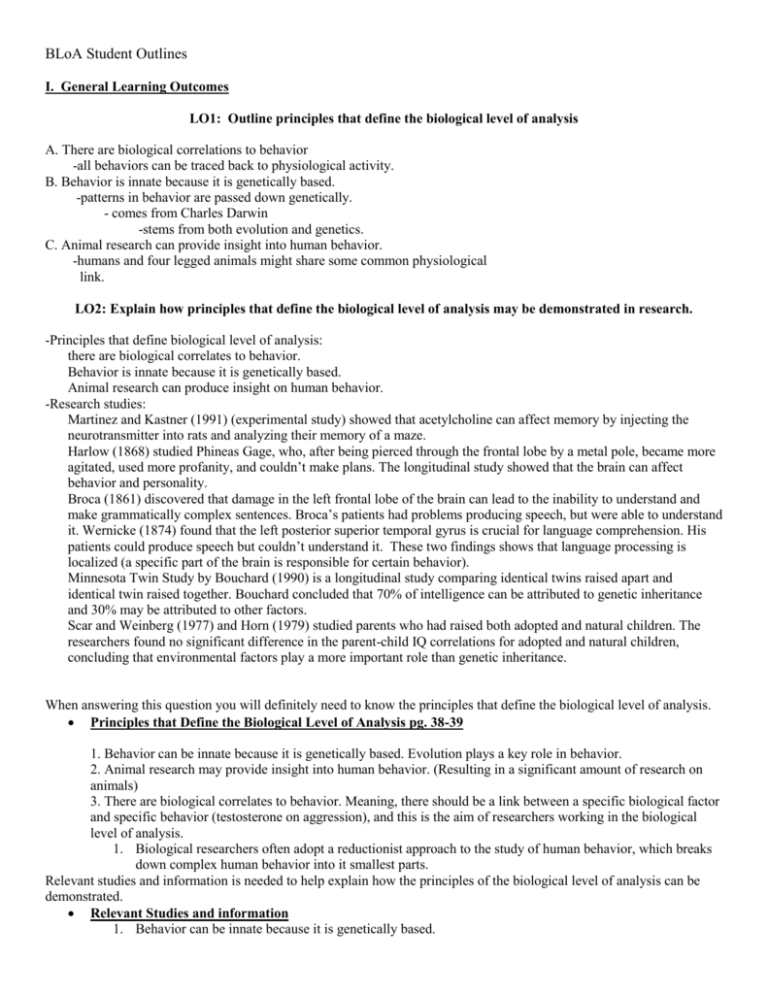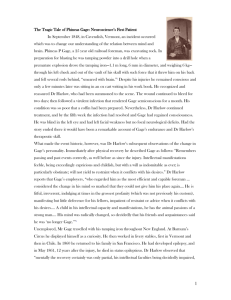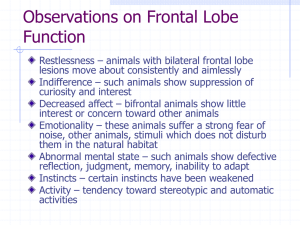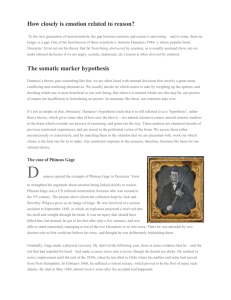BLoA Student Outlines I. General Learning Outcomes LO1: Outline
advertisement

BLoA Student Outlines I. General Learning Outcomes LO1: Outline principles that define the biological level of analysis A. There are biological correlations to behavior -all behaviors can be traced back to physiological activity. B. Behavior is innate because it is genetically based. -patterns in behavior are passed down genetically. - comes from Charles Darwin -stems from both evolution and genetics. C. Animal research can provide insight into human behavior. -humans and four legged animals might share some common physiological link. LO2: Explain how principles that define the biological level of analysis may be demonstrated in research. -Principles that define biological level of analysis: there are biological correlates to behavior. Behavior is innate because it is genetically based. Animal research can produce insight on human behavior. -Research studies: Martinez and Kastner (1991) (experimental study) showed that acetylcholine can affect memory by injecting the neurotransmitter into rats and analyzing their memory of a maze. Harlow (1868) studied Phineas Gage, who, after being pierced through the frontal lobe by a metal pole, became more agitated, used more profanity, and couldn’t make plans. The longitudinal study showed that the brain can affect behavior and personality. Broca (1861) discovered that damage in the left frontal lobe of the brain can lead to the inability to understand and make grammatically complex sentences. Broca’s patients had problems producing speech, but were able to understand it. Wernicke (1874) found that the left posterior superior temporal gyrus is crucial for language comprehension. His patients could produce speech but couldn’t understand it. These two findings shows that language processing is localized (a specific part of the brain is responsible for certain behavior). Minnesota Twin Study by Bouchard (1990) is a longitudinal study comparing identical twins raised apart and identical twin raised together. Bouchard concluded that 70% of intelligence can be attributed to genetic inheritance and 30% may be attributed to other factors. Scar and Weinberg (1977) and Horn (1979) studied parents who had raised both adopted and natural children. The researchers found no significant difference in the parent-child IQ correlations for adopted and natural children, concluding that environmental factors play a more important role than genetic inheritance. When answering this question you will definitely need to know the principles that define the biological level of analysis. Principles that Define the Biological Level of Analysis pg. 38-39 1. Behavior can be innate because it is genetically based. Evolution plays a key role in behavior. 2. Animal research may provide insight into human behavior. (Resulting in a significant amount of research on animals) 3. There are biological correlates to behavior. Meaning, there should be a link between a specific biological factor and specific behavior (testosterone on aggression), and this is the aim of researchers working in the biological level of analysis. 1. Biological researchers often adopt a reductionist approach to the study of human behavior, which breaks down complex human behavior into it smallest parts. Relevant studies and information is needed to help explain how the principles of the biological level of analysis can be demonstrated. Relevant Studies and information 1. Behavior can be innate because it is genetically based. Minnesota Twin Study (Bouchard et al 1999) pg. 54 Showed that identical and fraternal twins even when raised apart had very high concordance rates of intelligence, concluding it was most likely inherited. 2. Animal research may provide insight into human behavior. Take into consideration biological factors that humans and animals share Oxytocin, a hormone that plays a key role in inducing labor contractions and lactation, therefore can be seen in humans and other mammals. This hormone released with touches and hugs, and is associated with bonding between a mother and child, as well as with lovers. (pg. 49) o Consider the reasons why there is testing on animals: ex: experimenting on humans most of the time is ethically and morally wrong 3. There are biological correlates to behavior Rosenthal 1987, higher levels of melatonin contribute to seasonal affective disorder (SAD). pg 50 This principle can be demonstrated by finding the link between a hormone, body part, or neurotransmitter to a certain behavior in the human population. LO3: Discuss how and why particular research methods are used at the biological level of analysis LO4: Discuss ethical considerations related to research studies at the biological level of analysis. - - - - - Ethics – possible define Summary of Money (1974) David Reimer research study Summary of Schacter and Singer (1962) research study Protection o Individuals should be protected from any physical or mental harm o David Reimer Money (1974) David has his penis castrated (physical harm) Mental harm was inflicted by telling David the truth later in life (coincides with Cognitive LoA) Consent o Must be informed about what is being tested o Deceit can be introduced if no harm is to be expected o Under 18 – parental consent o David Reimer Money (1974) Twins and parents were not informed that they were in a study o Schacter and Singer (1962) Participants consented but not about the aims they were uninformed of Right to Withdraw o Should be able to withdraw at any time before publishing o No consequences from withdraw o David Reimer Money (1974) Cant withdraw if they were not informed of being part of a study Confidentiality o Anonymity so there are no resulting consequences o David Reimer Money (1974) Identity of twins was revealed Deception o Avoided as much as possible o May be employed if results would be skewed by the participants knowing the true aim o If deception is used it must be revealed at earliest point possible o David Reimer Money (1974) Family not informed of true nature of study David was not told that he was really a boy until later o Schacter and Singer (1962) - Deceived about aim of study Weren’t told which injection they received Some people had negative side effects (headache, etc.) Deception was justified Debriefing o Results and conclusion of research should be revealed as soon as possible to participants o Deception has to be revealed and justified to participants o David Reimer Money (1974) Family was not debriefed o Schacter and Singer (1962) Participants debriefed and deception was justified II. Physiology and Behavior LO5: Explain one study related to localization of function in the brain. Localization is when certain areas of the brain control different functions carried out in the brain; behaviors, emotions, and thoughts originate in the brain in specific areas. ● LOF Theory: certain parts of the brain correspond to specific functions carried out in the body ○ frontal lobe: reasoning, problem solving, creativity, judgement ● Damage to the brain can result in a loss of certain functions ● Brain breakdown ○ 2 main hemispheres: ■ left: logic, problem solving, controls right side of body ■ right: creativity, emotion, controls left side of body ○ 4 main lobes: ■ occipital: vision ■ frontal:reasoning, problem solving, creativity, judgement ■ temporal: perception, hearing, memory ■ parietal: senses and language ○ Other Areas: ■ broca’s: cant make language, but can understand language ■ wernicke’s: cannot understand language, but can make it ● Traditional issues of not being able to study a persons brain until they had died ○ Postmortem studies ○ Unethical to operate on while still alive without having todays technology ○ Could only study behavior ● Studies that focus on LOF ○ Phineas Gage, Harlow, 1849 ■ Gage got a pole blown through his head ■ nursed back to health by Harlow who monitored his behavior change ● Gage had undergone dramatic behavioral changes that he had not exhibited before ● concluded that Gage’s left prefrontal region had been altered, which explained his drastic change in behavior ○ “Tan”, Broca, 1861 ■ longitudinal case study on a boy named “tan” who could only make a few sounds Localization is when certain areas of the brain control different functions carried out in the brain; behaviors, emotions, and thoughts originate in the brain in specific areas. A. B. C. Brain divided into different hemisphere (left and right) and then into the frontal, temporal, parietal and occipital a. explain what each part is associated with Traditional issues of not being able to study a persons brain until they had died a. Post-mortem studies b. Unethical to operate on while still alive without having todays technology c. Could only study behavior Phineas Gage (Harlow 1849) a. Longitudinal study b. Railroad worker à explosionàmetal rod through cheek, through back of left eye and out of the prefrontal cortex c. After effects of how he changed: easy to aggravate, did not know how to act in public or react to situations, had a rough change in personality (once friendly then the exact opposite), unable to hold a job, unable to plan LO6: Using one or more examples, explain effects of neurotransmission on human behavior. Neurons o Define nerve cells that are the building blocks of behavior o How they communicate Electrochemical messages through process of neurotransmission Define what neurotransmission is a method by which messages are sent o As a result, a neurotransmitter is released Define neurotransmitter body’s natural chemical messengers which transmit information from one neuron to another & are stored in terminal buttons Examples of neurotransmitters and their effects: o Acetylcholine muscle contraction, and role in the development of memory in the hippocampus o Serotonin sleep, arousal levels, and emotion Supportive studies o Martinez & Kesner (1991) Aim to determine the role of acetylcholine on memory Methodology/ procedureexperiment; rats were trained to go through a maze and get to the end with food. One group of rats were injected with scopolamine (which blocks acetylcholine) Results/conclusion: the rats that were injected with scopolamine were slower finding their way around the maze and made more errors. Concluded that acetylcholine played a role in memory of maze o Kasamatsu & Hirai (1999) Aim to see how sensory deprivation affects the brain Methodology studied Buddhist monks during their stay on the mountain without food or water, communication, and exposure to the cold. Blood samples were taken before and after ascending the mountain. Concluded that sensory deprivation triggers the release of serotonin Results/conclusionafter 48 hours, they started hallucinating & seeing ancient ancestors of feeling their presence. They found serotonin levels had increased in the monk’s brains. Higher levels were in the hypothalamus and frontal cortex (causing hallucinations) LO7: Discuss two effects of the environment on physiological processes. LO8: Examine one interaction between cognition and physiology in terms of behavior. Evaluate two relevant studies. 1. Brain Plasticity -The ability for the brain to respond and adapt to outside experiences -Changes responses based on environmental changes Hubel and Weisel (1970) -Sutured one eye closed for 8 weeks in kittens -After the experiment, the kittens had blindness in the eye that was once closed -The brain rerouted itself so that connections to that eye were lost since it was note being used -Brain plasticity is based off the principle that if you do not use or do something frequently, you lose the ability to do it at all. 2. Stress on the Immune System -Experience through the stressor stimuli -Stress can give either physiological or Psychological responses -Insomnia, responses reflected through behavior Release of Stress Hormones -from Adrenal Gland -causes increased heart rate, constricts blood vessels, dilates air passages to allow more oxygen High Cortisol and Adrenalin levels -Can cause insomnia -High blood pressure -Deteriorating immune system -Overtime, it can cause coronary heart disease and cancer Kiecolt-Galser et al -75 first year medical students as the participants -Blood samples taken before and during their exams -Measured the level of T-cell activity in the blood for immune functioning levels -Surveys taken by participants on personal psychiatric symptoms -Students that claimed they felt lonely had more vulnerable immune systems -Stress decreases the functions of the immune system LO9: Discuss the use of brain imaging technologies in investigating the relationship between biological factors and behavior. o o o o examine the question cognition mental action or process of acquiring knowledge and understanding through thought, experience, and the senses. physiology branch of biology that deals with the normal functions of living organisms and their parts behavior way in which an animal or person acts in response to a particular situation or stimulus answer the question humans can influence the way the brain functions Richard Davidson (2004) 8 highly experienced meditative buddhist monks and 10 volunteers who had been trained in meditation for one week told to meditate on love and compassion o 2 controls and all monks had increase in number of gamma waves during meditation gamma waves = frequency pattern of brain activity o at the end of meditation, the 2 controls’ gamma waves dropped, but the monk’s gamma waves stayed relatively the same because monks are far more experienced in meditation, Davidson argued meditation can have significant long term effects on the brain and the process of emotion brain adapts to stimulation LO10: Using one or more examples, explain functions of two hormones in human behavior. The evolution of technology has allowed today’s psychologist to study an active brain; allowing them to see brain processes happen and how they are linked to certain behaviors. A. Before modern day technologyàpost-mortem studies a. Had to wait til person died to have an actual look at their brain b. Had to study their behaviors B. Had to carry research out on animals (ex. Rats) a. Invasive techniques i. Ablation and lesioning ii. Study the animals behaviors before and after surgeries iii. Ethical issues: damage can not be undone, pain to animals, potential harm and effects of surgeries can not be determined C. EEG (electroencephalogram) a. Studies “brainwaves” b. Limits: can not see what is going on in deeper regions of brain or show actual functioning of the brain D. fMRI (functional magnetic resonance imaging) a. 3D pictures of brain structures, using magnetic fields and radio waves. Shows actual brain activity, shows which areas of brain active when engaged in a behavior b. Higher resolution than PET scans c. Harris and Fiske (2006) and social cognition d. Lewis et al. (2007) and meditation E. PET (positron emission tomography) scan a. Monitors glucose metabolism levels in brain b.Can be used to diagnose abnormalities i. Ex. The differences between a normal patients brain the brain of someone who has a tumor or Alzheimers, or a psychological disorder c. Unlike the MRI can activities that continue (such as thinking) d. Raine et al. (1997) differences in people who have committed murders brains and others III. Genetics and Behavior LO11: With reference to relevant research studies, to what extent does genetic inheritance influence behavior? LO12: Examine one evolutionary explanation of behavior. LO 13: Discuss ethical considerations in research into genetic influences on behavior.







